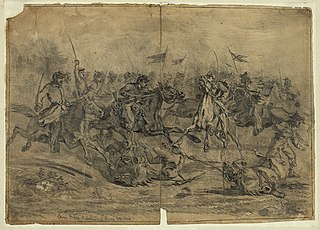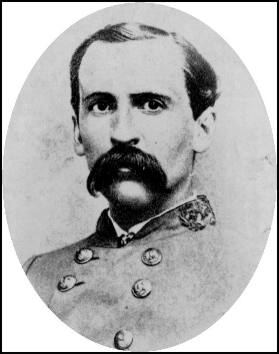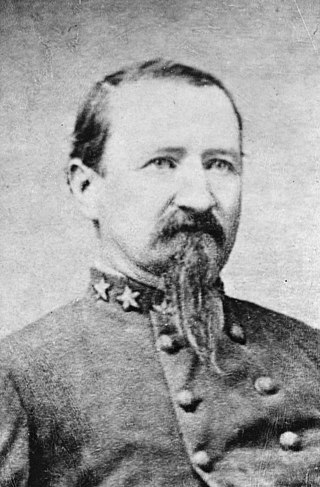
William Woods Averell was a career United States Army officer and a cavalry general in the American Civil War. He was the only Union general to achieve a major victory against the Confederates in the Valley Campaigns of 1864 prior to the arrival of Philip Sheridan, at the Battle of Rutherford's (Carter's) Farm and at the Battle of Moorefield.

The Battle of Brandy Station, also called the Battle of Fleetwood Hill, was the largest predominantly cavalry engagement of the American Civil War, as well as the largest ever to take place on American soil. It was fought on June 9, 1863, around Brandy Station, Virginia, at the beginning of the Gettysburg Campaign by the Union cavalry under Maj. Gen. Alfred Pleasonton against Maj. Gen. J. E. B. Stuart's Confederate cavalry.

Wesley Merritt was an American major general who served in the cavalry of the United States Army during the American Civil War, American Indian Wars, and Spanish–American War. Following the latter war, he became the first American Military Governor of the Philippines.

William Henry Fitzhugh Lee, known as Rooney Lee or W. H. F. Lee, was the second son of General Robert E. Lee and Mary Anna Custis. He was a planter, a Confederate cavalry General in the American Civil War, and later a Democratic Congressman from Virginia.

Alfred Pleasonton was a United States Army officer and major general of volunteers in the Union cavalry during the American Civil War. He commanded the Cavalry Corps of the Army of the Potomac during the Gettysburg campaign, including the largest predominantly cavalry battle of the war, Brandy Station. In 1864, he was transferred to the Trans-Mississippi theater, where he defeated Confederate General Sterling Price in two key battles, including the Battle of Mine Creek, the second largest cavalry battle of the war, effectively ending the war in Missouri. He was the son of Stephen Pleasonton and younger brother of Augustus Pleasonton.

David McMurtrie Gregg was an American farmer, diplomat, and a Union cavalry general in the American Civil War.

Hugh Judson Kilpatrick was an officer in the Union Army during the American Civil War, achieving the rank of brevet major general. He was later the United States Minister to Chile and an unsuccessful candidate for the U.S. House of Representatives.

Samuel Emerson Opdycke was a businessman and Union Army brigadier general during the American Civil War.
John Mercer Brockenbrough was a farmer and a Confederate colonel in the American Civil War.

Thomas Casimer Devin was a United States Army officer and general. He commanded Union cavalry during the American Civil War and during the Indian Wars.

The Battle of Buckhead Creek or Battle of Reynolds' Plantation was the second battle of Sherman's March to the Sea, fought November 28, 1864, during the American Civil War. Union Army cavalry under Brig. Gen. Hugh Judson Kilpatrick repulsed an attack by the small Confederate cavalry corps under Maj. Gen. Joseph Wheeler, but abandoned its attempt to destroy railroads and rescue Union prisoners of war.

Brigadier-General Abner Monroe Perrin was an American lawyer who served as a senior officer of the Confederate States Army in the American Civil War until he was killed in action at the Battle of Spotsylvania Court House.

Robert Houstoun Anderson was a West Point graduate, an infantry officer in the United States Army and served as a Brigadier General in the Confederate States Army during the American Civil War. After the war he served as the Chief of Police for the city of Savannah for 23 years and was twice appointed to serve on the Visitor's Board of the United States Military Academy at West Point, New York. With General Wheeler, General Anderson played an important role in reunification, recommending improvements and changes at West Point like electricity and the telephone in 1887.

Henry Baxter was a general in the Union Army during the American Civil War. At the Battle of Gettysburg, his brigade resisted a Confederate assault from parts of Maj. Gen. Robert E. Rodes's division, slaughtering hundreds in a surprise attack on BG Alfred Iverson's brigade, and held the north flank of the Union position for much of the day before retiring due to lack of ammunition. He was wounded four times during the war. He later served as President Grant's Minister to Honduras.

Samuel Beatty was an American soldier, sheriff, and farmer from Ohio. He was a brigadier general in the Union Army during the American Civil War. In 1866, he was awarded the brevet grade of major general of volunteers.

Julius H. Stahel-Számwald was a Hungarian soldier who emigrated to the United States and became a Union general in the American Civil War. After the war, he served as a U.S. diplomat, a mining engineer, and a life insurance company executive. He received the Medal of Honor for gallantry in action at the Battle of Piedmont in 1864.

John Baillie McIntosh was a Union Army brigadier general during the American Civil War. His brother, James M. McIntosh, served as a Confederate general until he was killed in the Battle of Pea Ridge.

Henry Marshall Ashby was a Confederate States Army colonel during the American Civil War. Although he commanded a brigade from June 1864 and a division at the Battle of Bentonville and through the surrender of the Confederate force under the command of General Joseph E. Johnston, he was never appointed a brigadier general by Confederate President Jefferson Davis or confirmed as a general officer by the Confederate Senate.

James Hagan was a United States Army captain during the Mexican–American War and a Confederate States Army colonel during the American Civil War. He was a prosperous businessman and planter at Mobile, Alabama, between the wars.
Moses Wright Hannon was a Confederate States Army colonel during the American Civil War. In August 1864, he was assigned to duty as an acting brigadier general by General John Bell Hood, subject to appointment by Confederate President Jefferson Davis and confirmation by the Confederate Senate. Although Hannon commanded a brigade in the cavalry corps of the Army of Tennessee and in Major General Joseph Wheeler's cavalry corps from June 1864 until the end of the war, he never was officially appointed by Jefferson Davis and confirmed by the Confederate Senate to brigadier general rank.


















